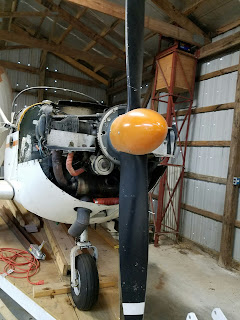I was able to track down the original builder Derek Reed. Looking at the blueprints he had to work with and reading through how he built the Playmate, I think Derek must have been an amazing man and I would love to meet him someday. Here's an excerpt of it's construction in his own words:
As far as I can recall it took about three years of spare time to make the Playmate.
It was started in the family room of the house we had at Redondo Beach CA..
All of the gas welding for the fuselage was done on a plywood table that I made along one side of the family room.
The initial welding instruction was given by Ted Greenlaw who was my flight instructor at Peninsular Aviation at Torrance Airport.
Ted was killed some years later flying supplies into I think Korea.?
I chose the Playmate as I was sharing a hanger and the folding wings made it possible to get two planes into that hanger.
During the construction Ray Stits did not prove to be of any assistance. His take was that if you couldn't read his plans you shouldn't be building his plane. !
One of the biggest challenges was the folding wing mounting brackets to the fuselage. getting the three bushings to line up was a chore, I must have made at least 6 pairs of mounting brackets before I got one to line up.
It was covered in 3,7 oz Dacron purchased from Burlington Mills back east.
I used the Stits covering process and painted it with Douglas aircraft surplus poly paint.
To get the fuselage and wings out of the house I conned my wife into letting me knock out one wall of the house, and my neighbor agreed to let me take the fences down between our two houses.
That gave me access to the alley at the back and into the garage.
Engine decking and final painting was done in the garage. The engine was purchased as a run out from Nagel Aircraft ,Torrance Airport for the princely sum of $800.and subsequently rebuilt by Northrop in Hawthorne.
At this point we moved to Torrance and I built a trailer to carry the plane on.
The initial flights were made from Chino airport, there were the usual hiccups, i.e....the trim tab was connected backwards..which made the first flight interesting. the engine had the wrong carb ,it had a smaller venturi which starved the engine of power WOT.[on the first flight].
The nose gear had a terrible shimmy which necessitated replacing it with a Metco Air unit and recalculate the W and B.
I don't recall how long I kept the Playmate, but sold it and bought a 1965 Mooney that had 350 hrs use in ~15 years sitting at Torrance tie down. That proved to be a great plane.

















